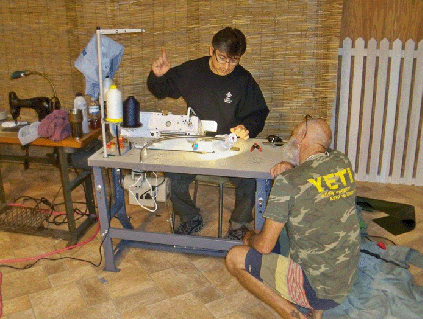Parachute Rigging Course
We offer two formal courses per year. The next course is April 21- May 2, 2025.
Instructors – Nancy LaRiviere, Bob "Fiesty" Fiesthamel, Sergio Cribas and Guest Speakers
COURSE OVERVIEW
____________________________
THEORY LECTURE TITLES
1. SAFETY
2. SEWING MACHINE ADJUSTMENT, MAINTENANCE AND TUNING
3. BASIC SEWING TECHNIQUES
4. MATERIAL IDENTIFICATION
5. INSPECTION
6. GROMMET SETTING, REMOVAL, REPAIR
7. STRUCTURAL & FUNCTIONAL COMPATIBILITY
8. KNOTS
9. FAR’S
____________________________
THEORY LECTURE CONTENT
• 1. SAFETY
Safety : brief on use of tools and of the potential for injury during the process, we can discuss and expand on what safety parameters we must have. Items such as hot knives, sharp blades, seam rippers, sewing machines can all pose the potential for injury.
____________________________
• 2. SEWING MACHINE ADJUSTMENT, MAINTENANCE AND TUNING
Sewing Machine Basics: a section on the operation of the machine and what can go wrong and how to fix it is a good idea before the student actually gets behind the machine.

• 3. BASIC SEWING TECHNIQUES
Three or four projects will be assigned to each student, such as:
• basic patch
• slider kill line channel replacement
• Grommet Hole repair
• Main riser toggle keeper replacement
• BOC replacement
_________________________
• 4. MATERIAL IDENTIFICATION
Material Identification: be able to identify common webbing, materials and hardware.
____________________________
• 5. INSPECTION
The purpose of the 180 repack cycle is inspection. Developing a methodology; use of checklists; common wear points.
___________________________
• 6. GROMMET SETTING, REMOVAL, REPAIR
Grommet Setting: basic removal and replacement and removal and replacement of stiffeners.
___________________________
• 7. STRUCTURAL & FUNCTIONAL COMPATIBILITY
Determining compatibility between approved components, understanding
FAA Advisory Circular 105-2c, the importance of bag extraction forces vs. effective pilotchute size and drag.
___________________________
• 8. KNOTS
Learn basic knots used in parachute rigging: Larks head, Bowline, Surgeons, Clove Hitch, Half Hitch, etc.
___________________________
• 9. FAR’s
Title 14 Code of Federal Regulations, Part 65 governing parachute riggers and Part 105 governing parachute jumping; you’ll see questions pertaining to this on the written exam and the oral exam.
____________________________
PRESUMPTIONS
• Six to eight course attendees
• Students are encouraged to do a few reserve pack jobs under the guidance and supervision of an FAA licensed rigger prior to the course if possible.
• Have read The Parachute Rigger Handbook (FAA H-8083-17).
• Begun studying and practicing the written exam using the Dauntless Aviation Parachute Rigger preparatory program or similar program.
____________________________
OBJECTIVES
Have completed 20 pack jobs of at least one Type.
Be prepared to take the Practical Rigger Exam.
Be prepared to take the FAA Written exam.
Leave more enlightened then when you came.
____________________________
Costs
Course Cost: $2000
Non-refundable deposit 2 weeks prior to the course: $500
FAA Practical Test following the course: $275 for Senior, $350 for Master. The first candidates who qualify will test early, maybe even before the formal course has finished. Those folks will then rejoin the class to continue learning.
We will help you make an appointment for your written FAA Exam through PSI at Embry Riddle Aeronautical University in Daytona Beach (just 18 miles drive). The cost to be paid to PSI is $175.
If you can find the Poynter’s Parachute Manual Vol. 1 and the Poynter’s Parachute Manual Vol. 2, we encourage you to buy them. They are unfortunately out
of print but can still be found.
Lodging is available at McLarty Farm (great place to stay: very clean, $25/day).